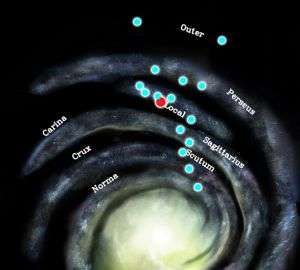Milky Way Mapping Project Finds Surprisingly Slow Stars

On Earth, making a map is as easy as taking aerial photographs or surveying a patch of land on foot. In contrast, mapping the Milky Way galaxy is a tremendous challenge. The distances are too large to travel, making bird's-eye views or direct surveys impossible.
Instead, astronomers must make do with the view from Earth, which is embedded in the galaxy itself. It's like a sardine, 400 miles offshore, trying to figure out the size and shape of the Pacific Ocean. For astronomers, the edge-on view and obscuring dust make it difficult to map anything farther than about 6,000 light-years, at least using visible light.
Now, ultra-precise radio measurements using the National Science Foundation's Very Long Baseline Array (VLBA) have given astronomers their first good look at the structure of the Milky Way and the motions of its young stars. Already, the measurements have turned up a big surprise: the mapped stars are orbiting slower than expected and moving in looping, oval paths rather than circling the galactic center.
"Almost all of our targets seem to have been accelerated opposite the direction of the galaxy's rotation," said Smithsonian astronomer Mark Reid (Harvard-Smithsonian Center for Astrophysics.) Reid discussed his findings today in a press conference at the 212th American Astronomical Society meeting.
Reid speculated that the accelerating force came from the galaxy's spiral arms. The Milky Way's spiral pattern comes from a phenomenon called a density wave, which acts like an astronomical traffic jam. Just as cars stuck behind a slow-moving truck catch up to each other and slow down, gas clouds approaching a spiral arm catch up to each other and slow down. They also compress, birthing the hot, young stars that Reid studied.
The slowing motion and resulting loss of angular momentum shift the stars' orbits from circular to elliptical. Since previous efforts to map the Milky Way assumed that stars orbit in circles, the resulting maps have intrinsic errors.
Reid used the VLBA to measure the parallax, or apparent shift in position on the sky as the Earth orbits the Sun, for masers in about a dozen star-forming regions. He then applied basic geometry to calculate highly accurate distances to each region. He also was able to observe the motion of each maser in the plane of the sky. Combining those data with motions along the line of sight yielded the true, 3-d motion of each target through space.
The VLBA's capabilities were crucial to this project. "The VLBA runs so smoothly that it makes my work easy," Reid said.
He added that the accuracy of the VLBA exceeds that of any other mapping instrument. "The previous gold standard, the Hipparcos satellite, could measure positions of stars to an accuracy of 1 milli-arcsecond. We're doing 100 times better with the VLBA."
Reid and his colleagues in Germany, Italy, and China plan to continue this mapping project by racking up several dozen more targets in the years to come. Ultimately, this work will help answer basic questions about the structure of the Milky Way.
"We don't even know how many spiral arms the Milky Way has-two or four," Reid explained.
Reid also looks forward to the launch of Hipparcos' successor, the European Space Agency's spacecraft Gaia. It will map the positions of up to 1 billion stars located as far as 30,000 light-years from Earth.
"Right now, our map of the Milky Way still has large areas marked 'Here there be dragons.' Ten years from now, those areas will be filled in," Reid said.
Source: Harvard-Smithsonian Center for Astrophysics



















